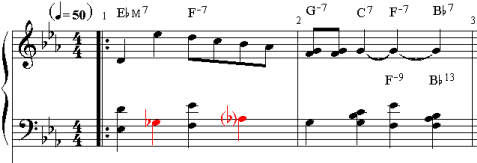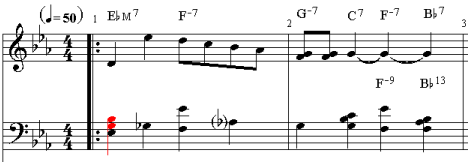Last time we polished off getting the base line set up to flow from measure one all the way to measure 4 in a fairly smooth transition. I promoted you to consider what things we might start to do with the chords in measure 1. So let's dig in and see where we can go today.
Here's where we left off.

Filling Out the Chord Tones
Beginning at measure 1 beat 1 we hinted that D in both the top and bottom clefs and that we'll need to drop the bass clef and add other notes. It's seems that the first thing we might do is remove the D in the bottom clef and add the rest of the chord notes.
So we end up with a straight Eb (3 note) chord to start off the song. Nothing wrong with that. Here you can see we have added a major 3rd and a 5th to get the root position chord.

Next I want to work with the next three beats. I've filled in some notes and we can walk through them.

In beat 2 of measure 1 I added the 5th and 7th chord tones, a great starting point. That makes the Eb on top a 13th interval with the addition of the 7th. Remember my rule is that if the seventh is included the even number intervals can be add to 7 to get the extended interval. Otherwise we might call it a 6th.
M1 Beat 3 I added just the 5th at this point to keep it simple. You might have added the 3rd instead or in addition. I'm leaving it this way because I'm considering some options in the treble clef later on.
M1 Beat 4 and in M2 beat 1 I've added both the 3rd and 5th intervals. Major 3rd for the Ab7 and a minor 3rd for the G-7.
Chord Internal Note Tone Movement
In M2 beat 3 I've added the minor 3rd. I've not added the 5th in this case because I've looked at the movement of notes from the C7 chord before it.
By using the just the minor third the C and Bb from the m2 beat 2 move to the Eb and Ab in beat 3 respectively, creating a nice movement of internal sound and fingering.
That's given us a bit to consider in the arrangement. So to wrap up you can try similar things for measure 3. As I was experimenting with this chords in this measure I considered doing something similar to what we did in measure one with half step leading voice.
Next time I'll show you how I went a little nuts and you can see if what you created is different than what I did.
Stay Tuned!
Really enjoy your series of articles. I wait in anticipation on more. 🙂
Regards
Marc
Thanks Marc, do hope that they provided some insight or gave you some ideas. I’ve used this basis for moving into improvisation as well. By using the theory as a base and applying the improvise for real methods, I am having a great time of creating music.